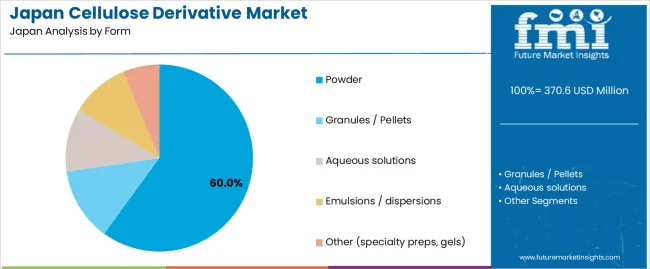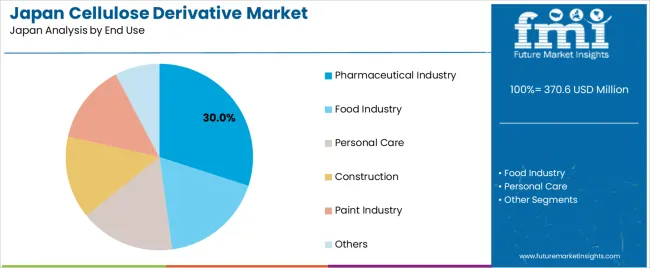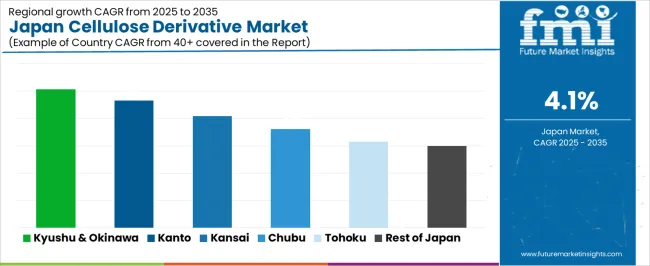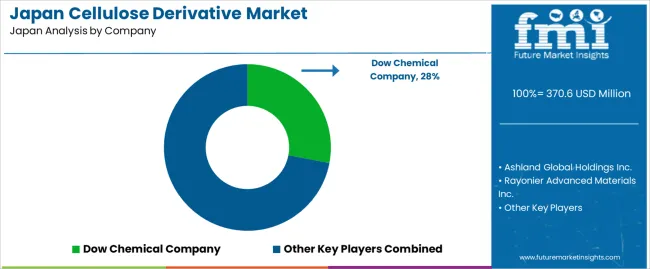The demand for cellulose derivatives in Japan is projected to grow from USD 370.6 million in 2025 to USD 551.2 million by 2035, reflecting a CAGR of 4.1%. Cellulose derivatives, including methyl cellulose, carboxymethyl cellulose, and ethyl cellulose, are used across a wide range of industries such as pharmaceuticals, food processing, cosmetics, and construction. The increasing demand for biodegradable, sustainable materials will continue to drive the growth of cellulose derivatives, as they are derived from renewable natural resources.
In the food industry, these derivatives are essential as thickeners, stabilizers, and gelling agents, and in pharmaceuticals, they are crucial as binders and excipients. The growing trend toward eco-friendly packaging, along with advancements in green chemistry, is expected to further boost demand for cellulose derivatives in the coming years.

The expanding use of cellulose derivatives in personal care products, paint and coatings, and textile manufacturing will also contribute to this steady market growth. As Japan continues to prioritize sustainability and natural-based products, cellulose derivatives will benefit from their ability to meet these demands, particularly in industries that require renewable, non-toxic, and biodegradable materials.
The long-term value accumulation curve for cellulose derivatives in Japan reflects a steady and consistent growth trajectory over the forecast period from 2025 to 2035, with gradual increases in market value each year. Starting at USD 370.6 million in 2025, the market will expand to USD 551.2 million by 2035, contributing a total increase of USD 180.6 million over the decade.
From 2025 to 2030, the market will grow from USD 370.6 million to USD 452.0 million, adding USD 81.4 million. During this period, the growth rate is expected to be relatively consistent as industries such as food processing, pharmaceuticals, and cosmetics continue to expand their use of cellulose derivatives. The early value accumulation will be driven by sustainability trends, regulatory pressures for safer products, and the increasing preference for renewable, eco-friendly materials in Japan.
Between 2030 and 2035, the market will grow from USD 452.0 million to USD 551.2 million, adding USD 99.2 million in value. The later phase will see stronger value accumulation as technological innovations in cellulose derivative applications open up new market opportunities. Advancements in the use of cellulose derivatives for biodegradable packaging and advanced pharmaceutical formulations will significantly contribute to the growth. Higher demand for natural and sustainable solutions in industries such as construction and personal care products will ensure that the demand for cellulose derivatives continues to increase, leading to consistent long-term value accumulation over the next decade. The growth curve suggests steady expansion, driven by industry innovations, sustainability needs, and eco-conscious consumer trends.
| Metric | Value |
|---|---|
| Sales Value (2025) | USD 370.6 million |
| Forecast Value (2035) | USD 551.2 million |
| Forecast CAGR (2025-2035) | 4.1% |
Demand for cellulose derivatives in Japan is driven by the country’s robust pharmaceutical, food, construction, and personal care industries, which utilize materials such as methyl cellulose, carboxymethyl cellulose, and hydroxypropyl cellulose for functionally enhanced water-based products. In pharmaceuticals, the derivatives serve as excipients, film-formers, and binders; in the food industry, they act as thickeners, stabilizers, and water-retention agents; and in construction, they are used in mortar and plaster systems. The cellulose ether and derivatives market in Japan is projected to grow at a compound annual growth rate (CAGR) of about 5.6% from 2024 to 2027.
Another factor boosting demand is Japan’s strong emphasis on sustainability, quality, and precision chemical manufacturing. Brands and formulators increasingly choose cellulose derivatives because they support clean-label design, renewable sourcing, and high performance. Innovations in functional chemistry, combined with tight regulatory standards and mature industrial infrastructure, make Japan a consistent market for specialty grades of cellulose derivatives. Challenges remain such as cost pressures, competition from alternatives, and feed-stock supply constraints. Nonetheless, the growth in high-value end-use segments and sustainability focus provide continued support for demand in Japan.
The demand for cellulose derivatives in Japan is driven by two key factors: form and end use. The leading form is powder, which holds 60% of the market share, while the dominant end-use sector is the pharmaceutical industry, accounting for 30% of the demand. Cellulose derivatives are versatile and widely used in various applications, including as thickeners, binders, stabilizers, and emulsifiers in industries such as pharmaceuticals, food, personal care, and construction. As Japan's focus on health, hygiene, and sustainable packaging increases, the demand for cellulose derivatives continues to rise.

Powder form leads the demand for cellulose derivatives in Japan, holding 60% of the market share. Powdered cellulose derivatives, such as hydroxypropyl methylcellulose (HPMC) and carboxymethyl cellulose (CMC), are widely used due to their ease of handling, versatility, and excellent performance across various industries. In the pharmaceutical industry, powdered cellulose derivatives are essential as excipients in tablet formulations, where they function as binders, disintegrants, and controlled-release agents.
The demand for powdered cellulose is also strong in the food and personal care sectors, where it is used to enhance texture, stability, and shelf life. Its ability to dissolve easily and form stable solutions or gels makes it a valuable ingredient in food products, cosmetics, and pharmaceutical formulations. As consumer demand for high-quality, multifunctional products continues to rise, the popularity of powdered cellulose derivatives in Japan is expected to grow, ensuring its continued dominance in the market.

The pharmaceutical industry is the leading end-use sector for cellulose derivatives in Japan, accounting for 30% of the market share. In the pharmaceutical sector, cellulose derivatives are primarily used as excipients in drug formulations, where they play a critical role in improving the stability, release profile, and consistency of the final product. Cellulose derivatives, such as HPMC and CMC, are commonly used in tablet and capsule formulations, where they act as binders, disintegrants, and controlling agents for the release of active pharmaceutical ingredients (APIs).
Japan’s strong pharmaceutical industry, known for its focus on innovation and high-quality standards, drives the demand for advanced excipients like cellulose derivatives. With an increasing focus on drug development, including controlled-release medications and high-precision treatments, the need for reliable and efficient excipients will continue to rise. This trend ensures that the pharmaceutical industry remains a major driver of the demand for cellulose derivatives in Japan. Additionally, as Japan’s aging population requires more pharmaceutical solutions, the demand for cellulose derivatives in this sector is expected to remain robust.
Demand in Japan for cellulose derivatives, such as methylcellulose, hydroxypropyl cellulose and ethyl cellulose, is driven by diverse applications in pharmaceuticals, food, personal care, construction materials and specialty chemicals. The domestic market values high-quality performance, purity and regulatory compliance, and the bio-based nature of cellulose derivatives aligns with Japan’s sustainability goals. At the same time, the mature nature of the industry and competition from alternative materials affect growth dynamics.
What are the Primary Growth Drivers For Cellulose Derivative Demand in Japan?
Several factors support growth in Japan. First, the strong pharmaceutical and medical device sectors require cellulose derivatives as excipients, coatings and binding agents, driving steady demand. Second, growth in clean label food, functional foods and personal care products encourages the use of plant based thickeners, stabilisers and encapsulants—which suit cellulose derivatives. Third, construction and renovation activity in Japan drives use of cellulose ethers in mortars, adhesives and plasters as water retention and rheology modifiers. Fourth, increasing focus on sustainability and renewable material sourcing makes cellulose derivatives more attractive relative to purely synthetic polymers.
What Are The Key Restraints Affecting Cellulose Derivative Demand in Japan?
Despite supportive factors, there are constraints. The cost of high performance cellulose derivatives can be significantly higher than commodity alternatives, limiting adoption in cost sensitive applications or where standard polymers suffice. Supply chain issues, such as feed stock availability and processing cost in a high labour cost country like Japan, may diminish competitiveness. Substitution threats from synthetic polymers or other bio polymers that offer similar performance at lower cost remain. Also, Japan’s mature market means that growth tends to be incremental rather than rapid, which limits volume expansion.
What Are The Key Trends Shaping Cellulose Derivative Demand in Japan?
Key trends include development of tailored cellulose derivatives with specific functionalities—for example ultra fine grades, modified surfaces and enhanced film forming capabilities—aimed at high value applications in coatings, electronics and pharmaceuticals. There is also growing interest in circular economy feed stocks, recycled cellulose and bio based processing to enhance sustainability credentials. In food and personal care, cellulose derivatives are increasingly used as clean label stabilisers, gelling agents and delivery systems. Partnerships between Japanese manufacturers and global specialty chem materials firms are becoming more common to localise production and shorten supply chains.
The demand for cellulose derivatives in Japan is rising across various industries, including food and beverages, pharmaceuticals, cosmetics, and paper production. Cellulose derivatives such as carboxymethyl cellulose (CMC), hydroxypropyl cellulose (HPC), and methylcellulose are valued for their versatility in thickening, binding, and gelling applications. As consumer demand for sustainable, natural ingredients and eco-friendly products grows, the use of cellulose derivatives as alternatives to synthetic additives is increasing. Additionally, the food industry’s focus on healthier, clean-label products is further driving this demand. Regional variations in demand are influenced by local industrial activity, population density, and specific regional needs in sectors like agriculture, food processing, and pharmaceuticals. Kyushu & Okinawa leads in demand due to agricultural production and growing industrial activities, while Kanto and Kinki follow with significant demand driven by industrial and manufacturing needs. This analysis explores the regional drivers of cellulose derivative demand in Japan.

| Region | CAGR (2025-2035) |
|---|---|
| Kyushu & Okinawa | 5.1% |
| Kanto | 4.7% |
| Kinki | 4.1% |
| Chubu | 3.6% |
| Tohoku | 3.2% |
| Rest of Japan | 3% |
Kyushu & Okinawa leads Japan in the demand for cellulose derivatives with a CAGR of 5.1%. The region’s significant agricultural base is a key factor driving the demand, as cellulose derivatives are widely used in food processing, particularly in the production of beverages, sauces, and processed food. The strong local agricultural output, including fruits and vegetables, drives the need for cellulose derivatives for food applications, especially for stabilizing, thickening, and enhancing texture.
In addition to the food sector, the region's pharmaceutical industry uses cellulose derivatives in tablets, coatings, and other drug formulations. Kyushu & Okinawa's growing industrial activities, coupled with the demand for natural and sustainable ingredients in various consumer products, ensure continued strong demand for cellulose derivatives.

The Kanto region shows strong demand for cellulose derivatives with a CAGR of 4.7%. As Japan’s economic and industrial center, Kanto, which includes Tokyo, has a large population and a high concentration of manufacturing and consumer goods industries. The food and beverage sector, which is a major consumer of cellulose derivatives for food applications such as gelling, binding, and stabilizing agents, is a key driver of demand in Kanto.
Furthermore, the pharmaceutical and cosmetics industries in Kanto rely heavily on cellulose derivatives in product formulations, including personal care, skincare, and over-the-counter medications. The region’s strong research and development sector, which focuses on natural and eco-friendly ingredients, further supports the growth of cellulose derivative demand. As consumer demand for clean-label and sustainable products continues to grow, Kanto will remain a major hub for cellulose derivative adoption.
The Kinki region demonstrates steady demand for cellulose derivatives with a CAGR of 4.1%. Kinki, home to Osaka and Kyoto, has a well-established industrial base, with a strong focus on manufacturing, including food processing, cosmetics, and pharmaceuticals. Cellulose derivatives are widely used in these industries for various applications, such as in emulsions, stabilizers, and excipients in pharmaceuticals.
The region’s high concentration of commercial activities, including food production and personal care products, ensures steady demand for cellulose derivatives. Additionally, Kinki’s strong research and innovation in the chemical and manufacturing sectors contribute to the continued use of cellulose derivatives in both traditional and emerging applications. The steady demand for cellulose derivatives in Kinki will remain supported by the region’s industrial activity and growing focus on sustainable production.
The Chubu region shows moderate growth in the demand for cellulose derivatives with a CAGR of 3.6%. Chubu, known for its automotive and manufacturing sectors, also has significant food processing and pharmaceutical industries. Cellulose derivatives are used in food applications for texturing, stabilizing, and binding, and in the pharmaceutical sector for coatings and excipients in drug formulations.
The region’s focus on innovation and advanced manufacturing, particularly in areas like machinery and chemicals, contributes to consistent demand for cellulose derivatives. As more industries in Chubu adopt sustainable and natural ingredients, demand for cellulose derivatives will continue to grow, albeit at a slower pace compared to more industrially focused regions.
Tohoku shows a CAGR of 3.2%, while the Rest of Japan follows with 3.0%. These regions experience slower growth in cellulose derivative demand due to their more rural and less industrialized nature compared to urban centers like Kanto and Kinki. However, demand is steady, particularly in food processing and local agricultural applications.
In Tohoku, cellulose derivatives are used primarily in the food sector, particularly for products like sauces and beverages. The Rest of Japan, which includes more diverse and smaller-scale industrial activities, also sees steady demand for cellulose derivatives in food, pharmaceuticals, and personal care products. As Japan continues to focus on sustainability and cleaner ingredients in manufacturing, the adoption of cellulose derivatives will gradually increase in these regions.

Demand for cellulose derivatives in Japan continues to rise, driven by their wide range of applications in industries such as food, pharmaceuticals, personal care, and industrial products. Companies like Dow Chemical Company (holding approximately 28% market share), Ashland Global Holdings Inc., Rayonier Advanced Materials Inc., CP Kelco, and Celanese Corporation are key players in this market. Cellulose derivatives such as carboxymethyl cellulose (CMC), hydroxyethyl cellulose (HEC), and methyl cellulose are valued for their properties as thickeners, stabilizers, and binders in food processing, drug formulations, cosmetics, and coatings.
Competition in the cellulose derivative market in Japan is driven by product performance, customization, and sustainability. Companies are focusing on developing derivatives with enhanced performance characteristics, such as improved solubility, better stability in various formulations, and compatibility with clean-label trends in food and cosmetics. Additionally, there is a strong emphasis on sustainable sourcing and manufacturing processes, as well as offering biodegradable or plant-based options in response to growing environmental concerns. Another competitive advantage is the ability to provide tailored solutions for specific industries, whether in the form of high viscosity grades for the food and beverage sector or specialized pharmaceutical-grade materials. Marketing materials often highlight features such as gelling properties, solubility, chemical stability, and compliance with industry regulations. By aligning their products with the increasing demand for high-performance and sustainable ingredients across various sectors, these companies are strengthening their position in the cellulose derivative market in Japan.
| Items | Details |
|---|---|
| Quantitative Units | USD Million |
| Regions Covered | Japan |
| Form | Powder, Granules / Pellets, Aqueous solutions, Emulsions / dispersions, Other (specialty preps, gels) |
| End Use | Pharmaceutical Industry, Food Industry, Personal Care, Construction, Paint Industry |
| Key Companies Profiled | Dow Chemical Company, Ashland Global Holdings Inc., Rayonier Advanced Materials Inc., CP Kelco, Celanese Corporation |
| Additional Attributes | The market analysis includes dollar sales by form and end-use categories. It also covers regional demand trends in Japan, particularly driven by the pharmaceutical, food, and personal care industries. The competitive landscape highlights key manufacturers in the cellulose derivative market, focusing on innovations in cellulose-based materials and their specialized applications. Trends in the growing demand for sustainable, multifunctional ingredients in consumer goods and industrial applications are explored, along with advancements in cellulose extraction and processing technologies. |
The global demand for cellulose derivative in japan is estimated to be valued at USD 370.6 million in 2025.
The market size for the demand for cellulose derivative in japan is projected to reach USD 551.2 million by 2035.
The demand for cellulose derivative in japan is expected to grow at a 4.1% CAGR between 2025 and 2035.
The key product types in demand for cellulose derivative in japan are powder, granules / pellets, aqueous solutions, emulsions / dispersions and other (specialty preps, gels).
In terms of end use, pharmaceutical industry segment to command 30.0% share in the demand for cellulose derivative in japan in 2025.






Our Research Products

The "Full Research Suite" delivers actionable market intel, deep dives on markets or technologies, so clients act faster, cut risk, and unlock growth.

The Leaderboard benchmarks and ranks top vendors, classifying them as Established Leaders, Leading Challengers, or Disruptors & Challengers.

Locates where complements amplify value and substitutes erode it, forecasting net impact by horizon

We deliver granular, decision-grade intel: market sizing, 5-year forecasts, pricing, adoption, usage, revenue, and operational KPIs—plus competitor tracking, regulation, and value chains—across 60 countries broadly.

Spot the shifts before they hit your P&L. We track inflection points, adoption curves, pricing moves, and ecosystem plays to show where demand is heading, why it is changing, and what to do next across high-growth markets and disruptive tech

Real-time reads of user behavior. We track shifting priorities, perceptions of today’s and next-gen services, and provider experience, then pace how fast tech moves from trial to adoption, blending buyer, consumer, and channel inputs with social signals (#WhySwitch, #UX).

Partner with our analyst team to build a custom report designed around your business priorities. From analysing market trends to assessing competitors or crafting bespoke datasets, we tailor insights to your needs.
Supplier Intelligence
Discovery & Profiling
Capacity & Footprint
Performance & Risk
Compliance & Governance
Commercial Readiness
Who Supplies Whom
Scorecards & Shortlists
Playbooks & Docs
Category Intelligence
Definition & Scope
Demand & Use Cases
Cost Drivers
Market Structure
Supply Chain Map
Trade & Policy
Operating Norms
Deliverables
Buyer Intelligence
Account Basics
Spend & Scope
Procurement Model
Vendor Requirements
Terms & Policies
Entry Strategy
Pain Points & Triggers
Outputs
Pricing Analysis
Benchmarks
Trends
Should-Cost
Indexation
Landed Cost
Commercial Terms
Deliverables
Brand Analysis
Positioning & Value Prop
Share & Presence
Customer Evidence
Go-to-Market
Digital & Reputation
Compliance & Trust
KPIs & Gaps
Outputs
Full Research Suite comprises of:
Market outlook & trends analysis
Interviews & case studies
Strategic recommendations
Vendor profiles & capabilities analysis
5-year forecasts
8 regions and 60+ country-level data splits
Market segment data splits
12 months of continuous data updates
DELIVERED AS:
PDF EXCEL ONLINE
Demand Signal Repository Solutions Market Size and Share Forecast Outlook 2025 to 2035
Demand Side Management Market Size and Share Forecast Outlook 2025 to 2035
Demand Response Market Analysis - Size, Share, and Forecast Outlook 2025 to 2035
North America Shipping Supplies Market Trends – Innovations & Growth 2024-2034
Demand of Kozani Saffron in Greece Analysis - Size, Share & Forecast 2025 to 2035
Demand of No-acid Whey Strained Dairy Processing Concepts in European Union Size and Share Forecast Outlook 2025 to 2035
Demand for Bronte Pistachio in Italy Analysis - Size, Share & Forecast 2025 to 2035
Demand and Trend Analysis of Gaming Monitor in Western Europe Size and Share Forecast Outlook 2025 to 2035
Demand and Trend Analysis of Gaming Monitor in Korea Size and Share Forecast Outlook 2025 to 2035
Demand and Trend Analysis of Gaming Monitor in Japan Size and Share Forecast Outlook 2025 to 2035
Glycine Soja (Soybean) Seed Extract Market Size and Share Forecast Outlook 2025 to 2035
Demand and Trend Analysis of Yeast in Japan - Size, Share, and Forecast Outlook 2025 to 2035
Demand of Pistachio-based desserts & ingredients in France Analysis - Size, Share & Forecast 2025 to 2035
Western Europe Men’s Skincare Market Analysis – Forecast 2023-2033
Demand and Trends Analysis of Stevia in Japan Size and Share Forecast Outlook 2025 to 2035
Japan Women’s Intimate Care Market Trends – Growth & Forecast 2024-2034
Demand and Trend Analysis of Fabric Stain Remover in Korea Size and Share Forecast Outlook 2025 to 2035
Demand and Sales Analysis of Paper Cup in Korea Size and Share Forecast Outlook 2025 to 2035
Demand and Sales Analysis of Paper Cup in Western Europe Size and Share Forecast Outlook 2025 to 2035
Demand of MFGM-enriched Powders & RTDs in European Union Size and Share Forecast Outlook 2025 to 2035

Thank you!
You will receive an email from our Business Development Manager. Please be sure to check your SPAM/JUNK folder too.
Chat With
MaRIA